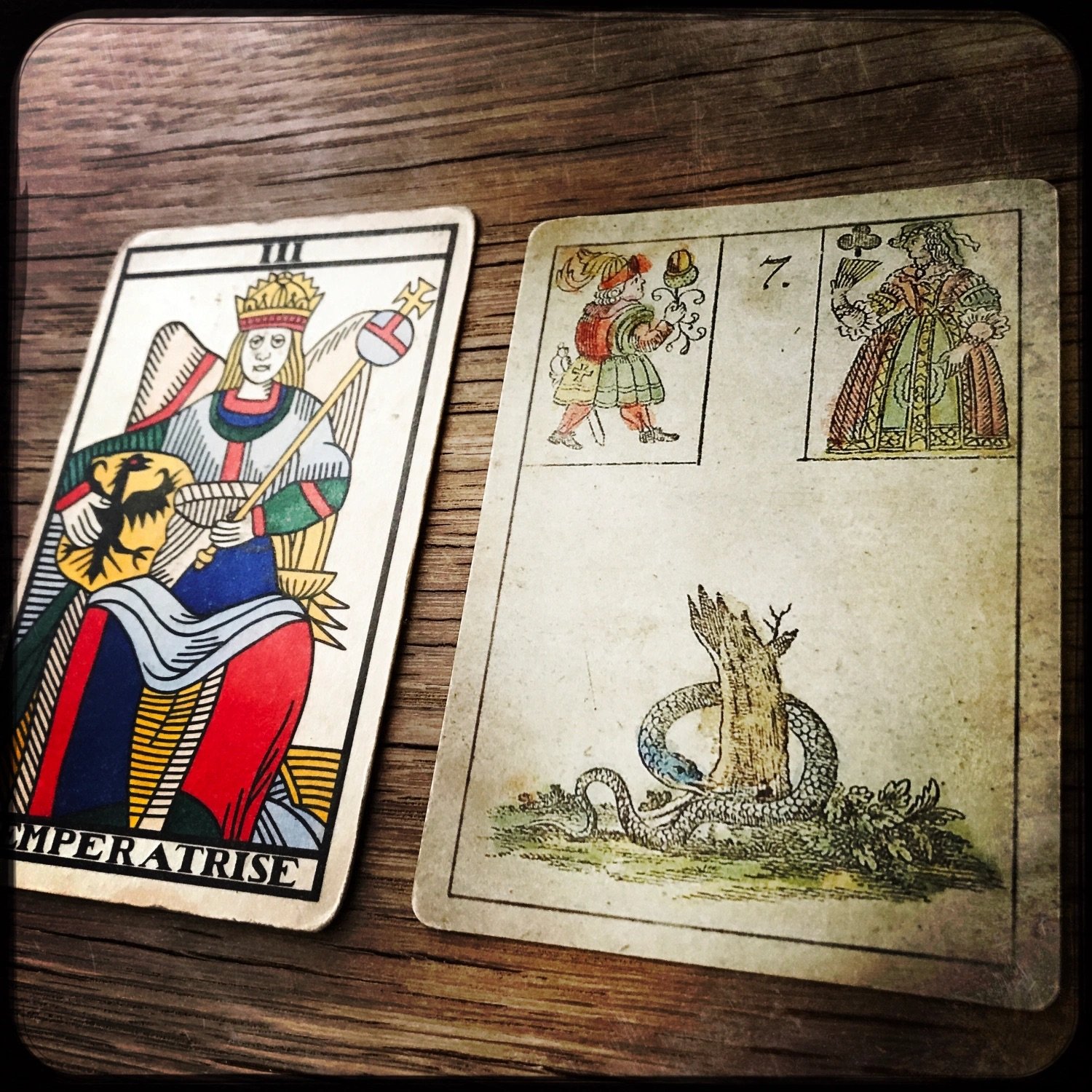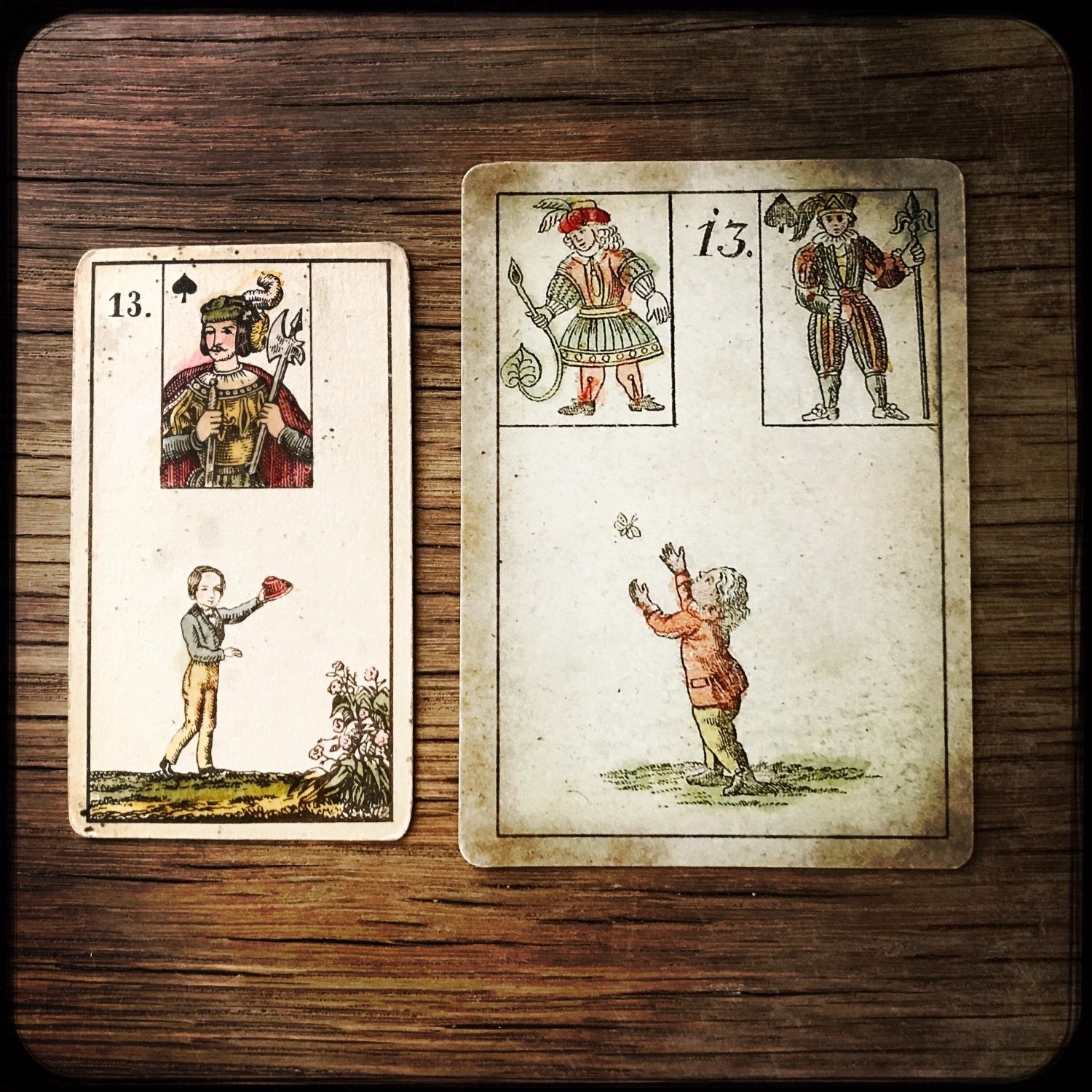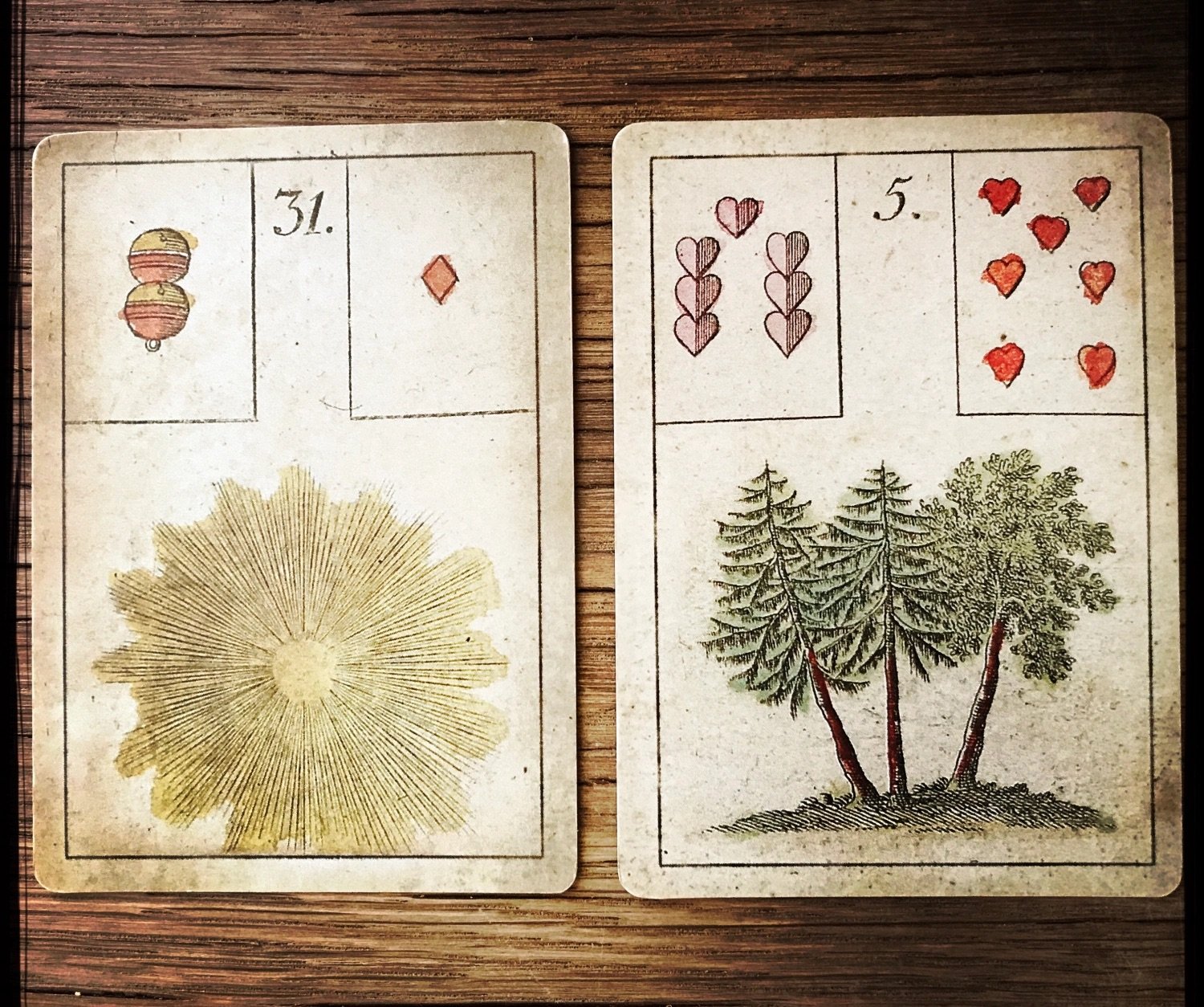Symbolism and function
Why I resist meaning?
Because that’s where magic happens. In that resistance. I sit with a set of cards and don’t go: ‘This means that’. ‘This means that’ requires an interpreter. An interpreter, when competent, occupies a liminal space, finding herself often at the crossing of languages, discourses, word and image.
When the interpreter is not fully competent – but can still be proficient in spite of it – she will find herself relying on definition and proclamation.
When the consolidation of an idea happens through definition – ‘this means that’ – things turn dogmatic, the liminal space going mainstream: ‘This means that. It’s been decided, now everyone relax. Stop thinking, stop reflecting, stop questioning. There’s nothing to be anxious about anymore. This means that.’ On the extreme occasion this line will also be followed by this proclamation: ‘This means that because this sacred meaning has been passed down to my family.’ Yeah, and I’m Napoleon, and it’s too bad for me that I’ve never heard of the illustrious family who holds the secret key to the meaning of cards…
So, sure, but no thanks. I’m not interested in killing the fun with the cards into a goddamn solemn thing. Magic is not found in things defined. Magic is not found in certainty. Quite the contrary. In the end, it comes down to what you want from the cards: Magic and mystery, or certitude and conviction; serious play or righteous solemnity.
Most would say, ‘I want magic,’ but then still take ‘meaning’ onboard because it feels safe and because it also makes others feel good. But meaning comes at a price, as meaning institutes a mechanism of identification that leads to uniformization. Uniformization is not magic.
Just think about it: identification only works when there’s a context that sustains it, however, false this context may be. The more you tell people that they can also be like the Empress, powerful and sovereign, the more they will like you. The more you point to the Snake as ‘the nasty, other woman,’ your rival, the more the ones you read the cards for will have an occasion to feel good about themselves: ‘I’m nothing like that Snake.’
While identification is the bread and butter of the fortuneteller, it poses little challenge if magic is what you want from the cards. Imagine seeing the cliché question, ‘does he love me?’ as fraught with magic every time you get it. Not many jaded diviners realize that what enables you to see the magic in all the things that get reduced to their meaning and definition is precisely resisting the way in which things abide in their cultural constructedness.
Magic is found in discovery, not in identifying this with that. Imagine looking at your cards and resist going: ‘This means that.’ Imagine looking at the cards and going: ‘I see it’s like this.’
When we operate with the Lenormand cards, unlike the Tarot, we note a marked difference: it’s more difficult to embody empowered states, as we don’t have many archetypes to look at. There’s no Empress here. No Emperor. There’s no Justice.
In the cards below we have the standard significator cards, Man and Woman, but they are depicted as mostly neutral, being devoid of any gesturing that might indicate what their story is. The Man holds firmly to his baton, while the woman makes an opening gesture with her fan. Given the history of these cards that go back to 1800, the story is the same old same old: then man is in control and the woman is waiting for his order. That’s it.
Unlike in the Tarot pack of cards where the function and symbolism of the cards are more elaborately distinct, what we have in the Lenormand pack is a series of highly stylized ideograms, or graphic representations of an idea or concept.
Most of the cards are static, acting as if in a nature morte setup. Very few cards act as narrative. The card of the Child presents us with a potential story in most of the classical decks: ‘Here’s my hat, you can have it,’ or ‘I’m chasing a butterfly without thinking where it will take me.’
Most of the other cards feature images that just sit there, or only carry an implicit suggestion of movement. We can only assume that the Letter is on its way. But we wouldn’t know for certain if we just looked at the card. A story of a letter that’s either delivered, lost, or on its way can only emerge if we also look at what other cards we have on the table. With the Heart next to it, would this be a love letter, or one of defamation if the Coffin is near it? Ay, rumors galore can circulate without verification, but they can never put bread on your table.
Now, the point I’m trying to make here is that the more stylized the tool we’re working with, the more there’s room for thinking about what we’re saying and why.
In this sense, the Lenormand cards are far more sophisticated than the Marseille, as there’s little here to embody and identify with.
At the same time, and because of their reductionist style, these cards are also more prone to abiding in meaning, simply because it’s safe. Cultural context and history also play a role. The Lenormand cards are made for the bourgeois, middle-class housewife whose primary concern is with family, the potential dark stranger who may come along to woo her daughter, or rivals in love or at work.
‘Here’s the Sun. It means happiness. The Tree is next to it. It means that your health is great.’
This is fair enough. Your divination is solid if you said things like that. But will it also be precise? Precision is not in the ‘meaning’ of the cards. As with magic, in divination precision is found in the crossing of aims, and the way context lends itself to the reading of the visual cues in the cards.
If you’re a professional and want more from your life and cards than having to repeat the same phrases over and over again, you’ll soon realize that ‘this means that’ doesn’t really cut it. You’ll be looking for the space where the magic is and where precision is.
In my teaching I insist on a simple formula that takes you out of the ‘meaning’ rut. Before there’s meaning, there’s function. Function must be related to a context and a question.
What’s the function of the Sun? To keep you warm. If it also signifies happiness will be entirely dependent on the context. The Arabs living in the desert have a consistent view of the Sun as a malefic star. You take your cards to Dubai and start reading them in a place without air conditioning, you’ll be presented with a lot of rolling of the eyes, if all you had to offer is ‘happiness.’ You’d have to do more than offer memoriezed phrases or memorized card combinations.
Anchoring your cards in magic
What I’m saying ultimately is this: learning to read the cards without making any resort to set meanings is a wonderful way of setting yourself free of the deadly boredom that the world of meaning and identification produces. You’ll be able to see what’s what, not other others have to say about it. It’s good to know of past vocabulary, but rely on it? Why would you? Because it sounds good?
It would be better instead to allow your cards to find you in that space where magic happens, for you’ll have taken the plunge towards fearlessly realizing that no interpreter of cards can make it better for you, if you yourself paid careful attention to what’s under your nose.
Identification works because it gives ‘meaning’ to life, but identification is never real. In the right context, the Sun and the Tree above can easily mean, ‘and they lived happily ever after.’ If a relationship is rooted in the Tree’s promise of longevity while the Sun shines on it, we’re right there with the very meaning of happiness. Yet meaning has no ground in reality simply because all we have to construe it with is words. Since words are made up of symbolic and conventional glyphs, what they point to is fiction, not reality.
Imagine divining knowing all this. Imagine reading the cards without the burden of having to feel anything, for after all, what is feeling if not the result of language? Granted, however, if I said to an anguished lover not to worry, because their lover is in it for the long haul, they’d feel something. So we go with that if it’s in the cards, but how real is the story of the experienced emotions?
I want a different kind of magic from my cards. For which reason I strip my discourse of all that interferes with the magic of just being there and occupying the space between myself and the other I read the cards for, without the tyranny of school and tradition. I want to be armed with just a keen and penetrating eye and a sense of what happens in the empty space between us, cards and humans. If people are touched by what I have to say, they will be touched because of the story that emerges from the cards right then and there. They will be touched by what I see happens in the cards that rings a bell for their own true justice. They will take my words for this seeing, not for the memory I can spare as a recollection of having been introduced to ‘the meaning of the cards.’
*
Learn more
For a thorough introduction to reading with the Lenormand cards, get my essential textbook on it, vol 111 in the Read like the Devil trilogy.







